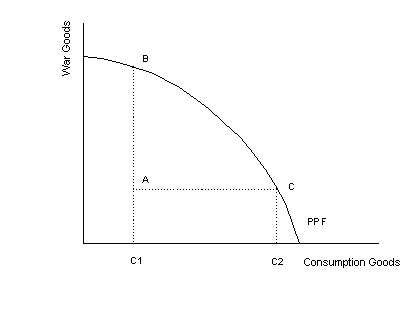-
1. Which of the following is "not" illustrated by a production possibility boundary?
- A. scarcity
- B. opportunity cost
- C. necessity for choice
- D. allocative efficiency
- E. all of the above are illustrated
Use the table below to answer question number 2
| "Guns" | 0 |
100 | 200 |
300 | 400 |
500 |
| "Bread" | 1000 |
900 | 750 |
550 | 300 |
0 |
- 2. Consider the above production possibilities table. The table shows the maximum combinations of bread and
guns that can be produced when all resources are fully employed.
We can conclude that:
- A. the opportunity cost of producing 200 guns instead of 100 guns is 750 units of bread.
- B. the opportunity cost of producing 500 guns instead of 300 guns is zero since we don't have to give up
any bread.
- C. the opportunity cost of producing 400 guns instead of 100 guns is 600 units of bread.
- D. the opportunity cost of producing 300 units of bread instead of 750 units of bread is 400 guns.
- E. none of the above.
3. Which of the following changes will have no effect on the production possibility boundary?
- A. the development of a new and superior fertilizer.
- B. an increase in unemployment.
- C. the development of a more productive method of steel production.
- D. growth in the labor force.
- E. all of the above affect the production possibility boundary.
4. All of the following would tend to increase a nations production possibilities EXCEPT:
- A. the society becomes more accepting of women who work.
- B. a new hybrid for wheat is discovered.
- C. a government program is instituted that encourages college education.
- D. the nation decides (by whatever method) to increase production of investment goods and decrease
production of consumption goods.
- E. all of the above would tend to expand a nations production possibilities.
5. Production possibility frontiers are thought to be concave from the origin (bowed out) because:
- A. of the different intensities with which commodities and services are used in producing capital, land,
and labor.
- B. land, labor, and capital are used in fixed proportions in producing all commodities and services.
- C. of the different intensities of people's labor efforts.
- D. all productive resources are equally suited for producing all goods.
- E. productive resources differ in their suitability for producing different goods.
6. Which of the following would tend to increase U.S. production possibilities in the future?
- A. the U.S. enters World War II.
- B. a new hybrid for wheat is discovered.
- C. a government program is instituted that encourages college education.
- D. the present wage differential between Mexico and the U.S. slowly erodes over time.
- E. none of the above will increase U.S. production possibilities in the future.
Use the graph below to answer question number 7

- 7. At the beginning of world war II, the U.S. moved from the
interior of their production possibility frontier to the
boundary. In the graph above, this is represented by a move
from point A to point B. What is the opportunity cost to the
U.S. of making that decision?
- A. since no consumption goods are sacrificed by moving from
point A to B, the opportunity cost is zero.
- B. while the opportunity cost is positive, it is impossible
to show it exactly on the graph.
- C. since the U.S. could have moved to point C rather than
point B, the opportunity cost of moving to point B is
the loss in potential consumption equal to the
horizontal distance C1 - C2.
- D. while it does not include the loss of any consumption
goods, the opportunity cost does include the loss of
american lives and property that occurred during the
war.
- E. none of the above.
8. Suppose you need to study six hours per week to earn a C, nine hours per week to earn a B, and 15 hours per
week to earn an A. This implies:
- A. increasing returns to hours studied.
- B. decreasing returns to hours studied.
- C. constant returns to hours studied.
- D. that extra study is a waste of time.
9. The "vicious circle of poverty" faced by many third world countries refers to the fact that:
- A. most third world countries are ruled by totalitarian or marxist governments that are unable or unwilling
to produce efficiently which leads to a vicious circle of poverty for their citizens.
- B. most third world countries are ruled by totalitarian or marxist governments that choose to produce
consumption goods for the ruling class while leaving most of the population in poverty.
- C. most third world countries have very little resources but large populations and must produce mainly
consumption goods just to feed their population at a subsistence level.
- D. most third world countries are unable to borrow a sufficient amount of money from developed countries
to allow investment in capital goods.
- E. none of the above.
 Previous Topic
Previous Topic
 Next Topic
Next Topic
